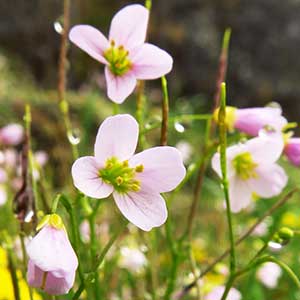Cardamine maxima
Cardamine pattersonii
large toothwort
Saddle Mountain bitter-cress
cylindrical, 3–6 mm diam., (distinctly constricted at intervals, non-uniform diam., fleshy, slightly fragile, with dentate leaf scars).
cylindrical, slender, 0.5–1.5 mm diam.
erect, unbranched, 0.9–3(–4) dm.
(simple from base), erect, (not flexuous), unbranched or branched basally, 0.6–3 dm.
rosulate or not, 3 or 5-foliolate, 1–6 cm, leaflets petiolulate;
petiole 0.4–2.5 cm;
lateral leaflets similar to terminal, considerably smaller;
terminal leaflet (petiolule 0.1–0.4 cm), blade obovate to orbicular or subcordate, 0.3–1.5(–2.0) cm × 2.5–16(–18) mm, base obtuse to rounded or cordate, margins entire or dentate to slightly sinuately lobed.
3-foliolate, 7–20 cm, leaflets petiolulate or subsessile;
petiole 4–15 cm;
lateral leaflets subsessile or petiolulate, blade often similar to terminal, base often oblique;
terminal leaflet (petiolule 0.2–1(–1.7) cm), blade broadly ovate to oblong, 2–7.5 cm × 12–37 mm, base cuneate to obtuse, margins coarsely dentate to sharply incised, or deeply cleft into 2 or 3 lobes (lobes dentate or incised, margins puberulent).
2 or 3, 3-foliolate, (rarely subopposite), petiolate, leaflets petiolulate or subsessile;
petiole (0.5–)1–4(–6.5) cm, base not auriculate;
lateral and terminal leaflets similar to rhizomal, distalmost sometimes much smaller.
2–4, 3 or 5-foliolate, blade similar to basal, gradually reduced in size as bract, distalmost ones subtending pedicels of flowers (usually simple);
leaflet blade or bract linear to linear-oblanceolate, 0.2–0.8 cm.
ebracteate.
bracteate throughout.
sepals (erect to ascending), oblong, 5–7 × 2–3 mm, lateral pair slightly saccate basally;
petals white or pink, oblanceolate, 10–17 × 3–6 mm, (not clawed, apex rounded);
filaments: median pairs 4–8 mm, lateral pair 3–6.5 mm;
anthers linear, 1.7–2.7 mm.
sepals oblong, (2–)3 × 0.7(–1) mm, lateral pair not saccate basally;
petals purple or pink, obovate, 6–9 × 3–4 mm, (not clawed);
filaments: median pairs 3–3.5 mm, lateral pair 2–2.5 mm;
anthers oblong, 0.7–1 mm.
(flowering ones) horizontal to divaricate or deflexed, 7–20 mm.
divaricate-ascending, (10–)15–30(–45) mm.
(undeveloped), linear-lanceolate, to 3 cm × 2 mm;
ovules 10–14 per ovary;
style 3.5–7 mm.
linear, (torulose), 2–3 cm × 1–1.5 mm;
ovules 14–20 per ovary;
style 2–4 mm.
not known.
brown, oblong to ovoid, 1.7–2.2 × 1–1.5 mm, (winged distally).
= 120, 124, 132, 138, 156, 161, ca. 208.
Cardamine maxima
Cardamine pattersonii
Cardamine maxima has not been found with mature fruits and seeds and it has long been suspected to be a hybrid between C. concatenata and C. diphylla. Molecular studies (P. W. Sweeney and R. A. Price 2000) indicate that C. maxima is distinct from both those species. Although we hesitate to maintain it as a species, its wide distribution and morphological distinctness warrant its recognition.
(Discussion copyrighted by Flora of North America; reprinted with permission.)
Of conservation concern.
Cardamine pattersonii is known from Saddle Mountain and Onion Peak in Clastop County.
(Discussion copyrighted by Flora of North America; reprinted with permission.)


